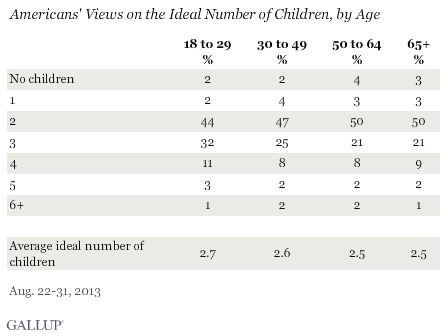PRINCETON, NJ -- Despite the recent drop in the U.S. fertility rate, Americans' attitudes about having children have remained unchanged over the past 23 years. More than nine in 10 adults say they already have children, are planning to have children, or wish that they had had children. The 5% of American adults who do not want children is virtually the same as the 4% found in 1990.
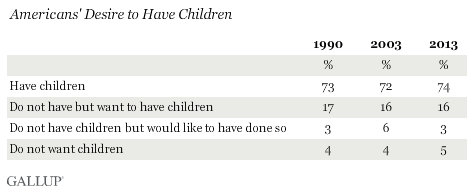
The U.S. Centers for Disease Control and Prevention report that the U.S. general fertility rate reached an all-time low in 2011, at 63.2 births per 1,000 women aged 15 to 44. The fertility rate has dropped 11% from 1990, when there were 70.9 births per 1,000 women aged 15 to 44.
The finding from Gallup's Aug. 22-31 survey suggests that the changes in the U.S. birthrate in the last few decades apparently are not related to a change in Americans' underlying attitudes toward children. It may be that fewer women are having children or that women, on average, are having fewer children, but the data show that the general interest in having children has remained constant -- and high.
Younger Americans Want Children; Those With Kids Would Repeat Decision
More than half of Americans between the ages of 18 and 40 have children, and another 40% do not currently, but hope to have children someday. Only six percent of Americans aged 18 to 40 do not have, and do not want to have, children.
These views are essentially unchanged from 2003, when 94% of Americans between the ages of 18 and 40 either had children or wanted to have children someday.

Meanwhile, 86% of Americans aged 45 or older have had children, and nine in 10 of these say they would have children if they had to "do it over again." Of the 14% of Americans aged 45 and older who do not have children, 50% say that if they had to do it over again, they would have at least one child.
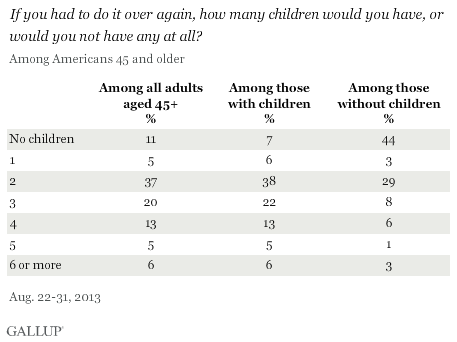
Combined, more than nine in 10 older Americans either have children (86%) or wish they had (7%).
Americans' Ideal Number of Children per Family Stable for Decades
Americans say the ideal number of children per family is 2.6, which is on par with what Gallup has found since the late 1970s.
Gallup has been asking Americans "What do you think is the ideal number of children for a family to have?" since 1936, when the ideal number per family was 3.6, on average. This number declined between 1957 and 1978 to an average of about 2.5 children, where it remains today.
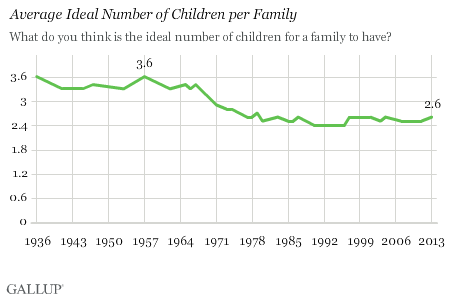
Americans of all ages report that about the same number of children would be ideal, with younger Americans (18 to 29) having a slightly higher ideal average (2.7) than those 65 and older (2.5). For complete results for this question, see page 2.
Finances and the Economy Main Reason for Limiting Number of Children
More than three-quarters of Americans feel the main reason couples do not have more children is finances or the economy, and those who do have children agree on this point with those who do not. This finding underscores that it is not a change in attitudes, but something else, that is behind the recent drop in the U.S. fertility rate.
Specifically, most Americans (65%) mention not having enough money or the cost of raising a child, and another 11% name the state of the economy or the paucity of jobs in the U.S. If Americans' perceptions are accurate, the fertility rate could increase as the U.S. economy improves.
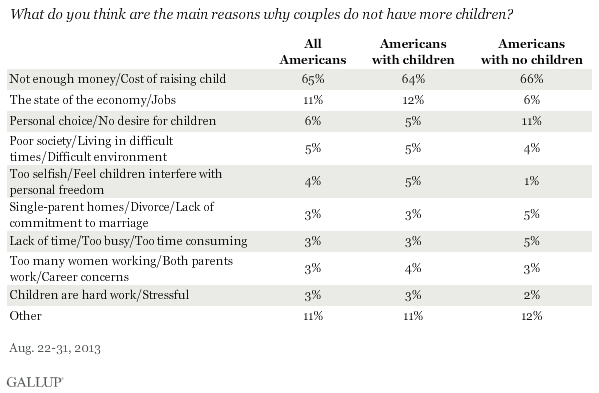
Bottom Line
The drop in the U.S. fertility rate has caused a media buzz recently. For example, Time magazine's August cover story indicated that Americans are beginning to embrace a life without children. While that may be true for a small number of Americans, it does not describe Americans more generally.
Americans are just as likely now as they were more than two decades ago to have children, want to have children, or wish they had had children. And this positive attitude toward children is evident in both those of childbearing age, and those who are older. Further, younger adults on average agree with older Americans as to the ideal family size.
Because many of the reasons Americans mention for couples not having more children are related to finances and the state of the economy, it is possible that economic improvement will activate the nearly universal desire for children -- and thus correspond with an increase in the fertility rate.
Survey Methods
Results for this Gallup poll are based on telephone interviews conducted Aug. 22-31, 2013, on the Gallup Daily tracking survey, with a random sample of 5,100 adults, aged 18 and older, living in all 50 U.S. states and the District of Columbia.
For results based on the total sample of national adults, one can say with 95% confidence that the margin of sampling error is ±2 percentage points.
For results based on the total sample of 3,899 parents, one can say with 95% confidence that the margin of sampling error is ±2 percentage points. For results based on the total sample of 719 adults who do not have children, the margin of error is ±5 percentage points.
Interviews are conducted with respondents on landline telephones and cellular phones, with interviews conducted in Spanish for respondents who are primarily Spanish-speaking. Each sample of national adults includes a minimum quota of 50% cellphone respondents and 50% landline respondents, with additional minimum quotas by region. Landline and cell telephone numbers are selected using random-digit-dial methods. Landline respondents are chosen at random within each household on the basis of which member had the most recent birthday.
Samples are weighted to correct for unequal selection probability, nonresponse, and double coverage of landline and cell users in the two sampling frames. They are also weighted to match the national demographics of gender, age, race, Hispanic ethnicity, education, region, population density, and phone status (cellphone only/landline only/both, and cellphone mostly). Demographic weighting targets are based on the March 2012 Current Population Survey figures for the aged 18 and older U.S. population. Phone status targets are based on the July-December 2011 National Health Interview Survey. Population density targets are based on the 2010 census. All reported margins of sampling error include the computed design effects for weighting.
In addition to sampling error, question wording and practical difficulties in conducting surveys can introduce error or bias into the findings of public opinion polls.
View methodology, full question results, and trend data.
For more details on Gallup's polling methodology, visit www.gallup.com.
